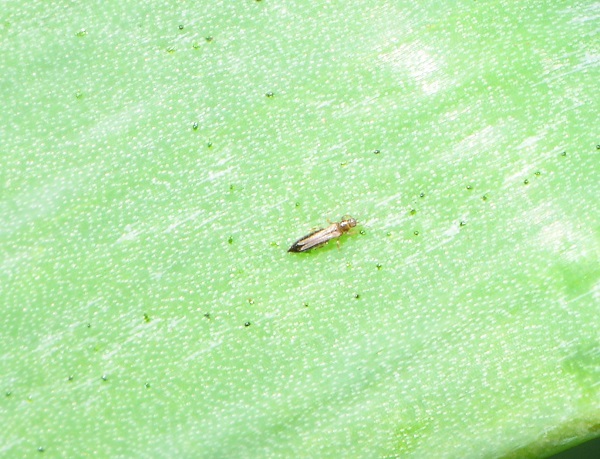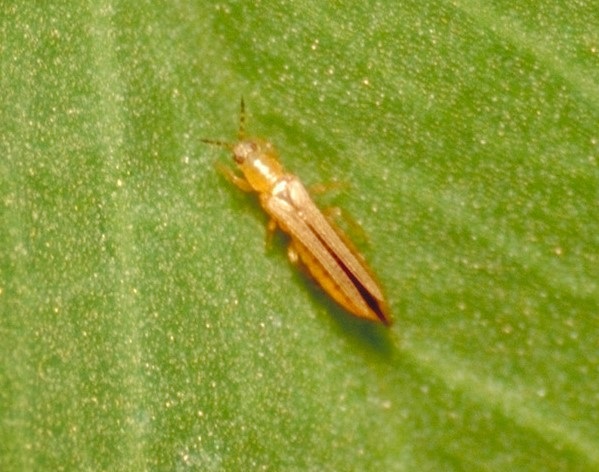Thrips Management With Onions
ENTFACT-317: Thrips Management With Onions | Download PDF
Ric Bessin, Extension Specialist
University of Kentucky College of Agriculture
Thrips are serious pests of onions throughout the United States and can be troublesome to manage. Thrips are tiny winged pests, only about 1/20 of an inch in size. They feed with piercing-sucking and rasping mouthparts. While both onion thrips (Thrips tabaci) and western flower thrips (Frankliniella occidentalis) can attack onions, generally, the onion thrips is more common and serious.

Figure 1. An onion thrips and its damage.
Thrips damage to onions results in both loss of yield and reduction in storage quality with bulb onions. Thrips are most damaging during the early bulb development stage. Infested plants may have leaves that are scarred (stippled appearance) and do not elongate properly resulting in twisted or crinkled leaves. With green onions, leaf scarring reduces marketability.
In Kentucky, development from egg to adult is estimated to take as little as 20 days, with 6 to 8 generations per year. The female inserts eggs into plant tissue with the nymphs emerging 4 to 10 days later. The nymphs feed for 5 to 7 days before pupating in the soil. In less than a week the adults emerge from the soil. Thrips overwinter in grasses, clover and alfalfa fields and continue to feed and develop during warm periods. In our state, these pests are favored by a mild, dry winter followed by a hot, dry spring. These weather patterns may allow for higher survivorship during the winter and early spring buildup. Infestations are greatest in hot, dry weather.

Figure 2. A western flower thrips.
Thrips prefer to feed on the newest leaves, usually concealed in the leaf sheaths. As the leaf expands, the damage enlarges. Feeding results in leaves with a whitish or tan appearance.
Growers should check for thrips as bulbs begin to form. Onion varieties vary in susceptibility to thrips injury, with some white and yellow varieties more tolerant. Thresholds vary from 10 to 25 per plant for susceptible varieties to as many as 45 per plant for more tolerant varieties. Where insecticides are needed, treat during early bulb stage. Direct ground-applied sprays toward the center of plants and use spray volumes of 30 or more gallons per acre. Wetting agents aid in control. Pesticide resistance is becoming very common with onion thrips in some regions of the U.S.
Revised: 11/19
CAUTION! Pesticide recommendations in this publication are registered for use in Kentucky, USA ONLY! The use of some products may not be legal in your state or country. Please check with your local county agent or regulatory official before using any pesticide mentioned in this publication.
Of course, ALWAYS READ AND FOLLOW LABEL DIRECTIONS FOR SAFE USE OF ANY PESTICIDE!
Photos courtesy Ric Bessin, University of Kentucky Entomology
